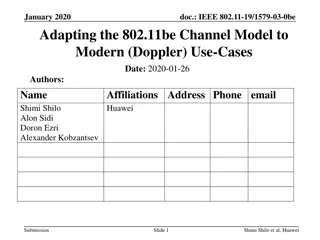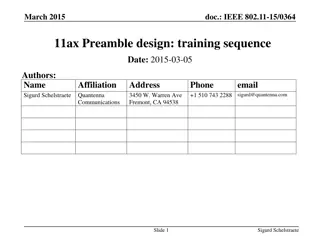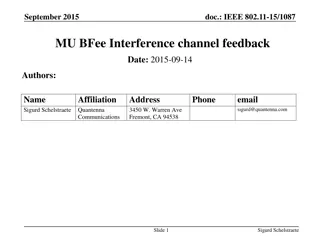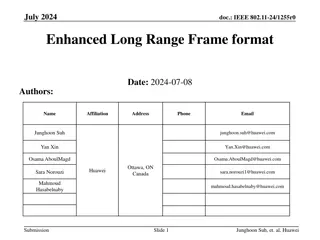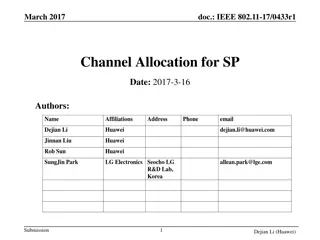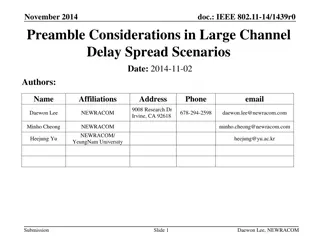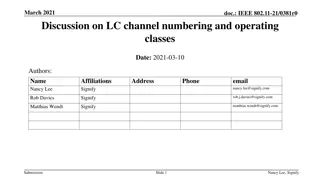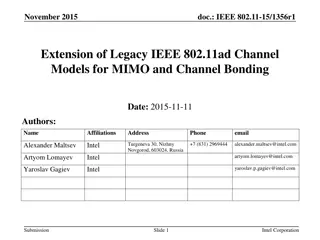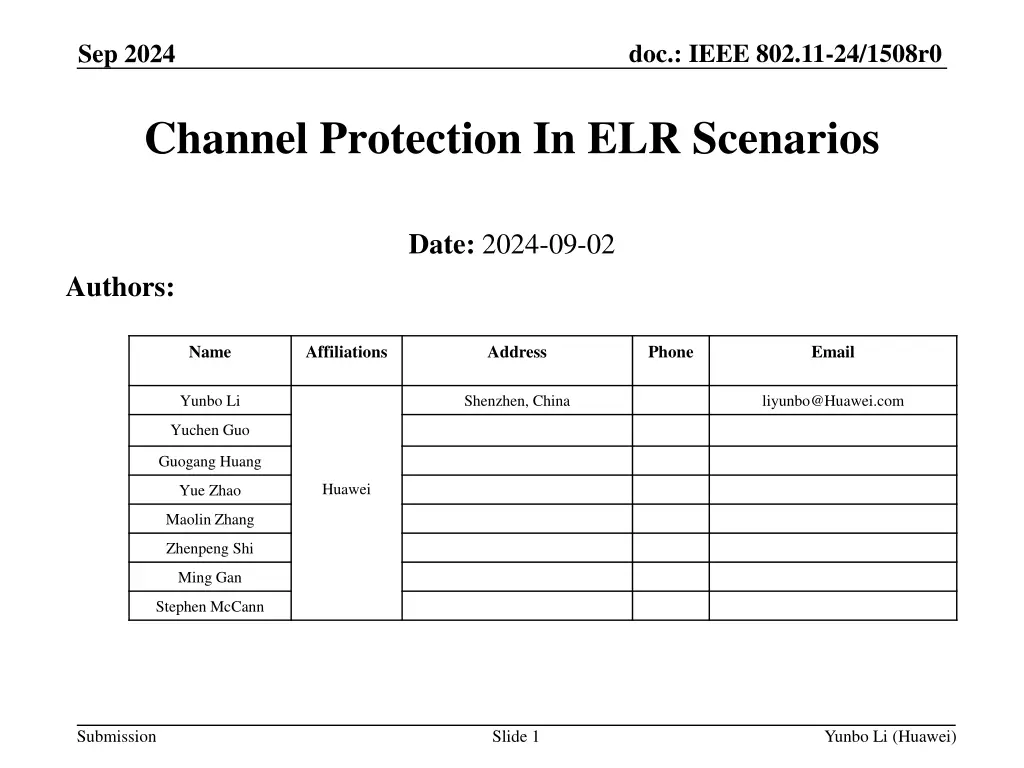
Channel Protection in ELR Scenarios
Explore the challenges and solutions related to hidden node issues in Enhanced Long Range (ELR) scenarios in the context of IEEE 802.11 standards. Addressing the link budget imbalance and power differences between uplink and downlink communications, this document delves into the implications for different types of STAs transmitting ELR PPDU. Learn about the complexity introduced by potential scenarios where only specific STAs can transmit ELR PPDU and considerations for channel protection in such cases.
Download Presentation

Please find below an Image/Link to download the presentation.
The content on the website is provided AS IS for your information and personal use only. It may not be sold, licensed, or shared on other websites without obtaining consent from the author. If you encounter any issues during the download, it is possible that the publisher has removed the file from their server.
You are allowed to download the files provided on this website for personal or commercial use, subject to the condition that they are used lawfully. All files are the property of their respective owners.
The content on the website is provided AS IS for your information and personal use only. It may not be sold, licensed, or shared on other websites without obtaining consent from the author.
E N D
Presentation Transcript
doc.: IEEE 802.11-24/1508r0 Sep 2024 Channel Protection In ELR Scenarios Date: 2024-09-02 Authors: Name Affiliations Address Phone Email Yunbo Li Shenzhen, China liyunbo@Huawei.com Yuchen Guo Guogang Huang Huawei Yue Zhao Maolin Zhang Zhenpeng Shi Ming Gan Stephen McCann Submission Slide 1 Yunbo Li (Huawei)
doc.: IEEE 802.11-24/1508r0 Sep 2024 Introduction A motion about ELR 11bn; Move to include the following in the 11bn SFD: Define Enhanced Long Range (ELR) PPDU and potentially other Range Extension mechanisms. The main use case is to overcome the link budget imbalance between uplink and downlink Usually uplink link budget is smaller than downlink, e.g. up to 6dB. The hidden node issue is more serious due to reasons below The legacy STA can not understand an ELR PPDU The normal PPDU doesn t provide a large coverage We will discuss the hidden node issues under various ELR scenarios and suggest some procedures. Enhanced Long Range PPDU has been passed in Submission Slide 2 Yunbo Li (Huawei)
doc.: IEEE 802.11-24/1508r0 Sep 2024 Hidden Node Issues Under ELR Scenarios There are two types of STAs with different capabilities STA11 and STA12 can transmit both normal and ELR PPDUs ; STA21 and STA22 can only transmit normal PPDUs When AP and STA11 do an RTS/CTS frame exchange using normal PPDUs, the CTS can not be correctly received by the AP. STA12 RTS @ normal PPDU STA11 AP CTS @ normal PPDU STA21 STA22 Submission Slide 3 Yunbo Li (Huawei)
doc.: IEEE 802.11-24/1508r0 Sep 2024 Hidden Node Issues Under ELR Scenarios There are two types of STAs with different capabilities STA11 and STA12 can transmit both normal and ELR PPDUs ; STA21 and STA22 can only transmit normal PPDUs When AP and STA11 do an RTS/CTS frame exchange through ELR PPDUs, a legacy STA can not understand the ELR PPDU, thus they will not respect the NAV protection. STA12 RTS @ ELR PPDU STA11 AP CTS @ ELR PPDU STA21 STA22 Submission Slide 4 Yunbo Li (Huawei)
doc.: IEEE 802.11-24/1508r0 Sep 2024 Use Case 2 There are two possible cases Case 1: only a non-AP UHR STA can transmit ELR PPDUs; Case 2: both a UHR AP and non-AP UHR STA can transmit ELR PPDUs; The TGbn standard hasn t made a decision that supports case 1 or case 2, or case 1 in some bands and case 2 in the other bands; As it probably will be an optional feature, it will be good to assume case 1 when discussing channel protection due to below reasons The main scenarios that need to improve the channel protection is the power imbalance between UL and DL, in which case the target non-AP STA can correctly receive a non-ELR PPDU sent from the associated AP, so AP doesn t need to transmit frame in ELR PPDU; When considering both case 1 and case 2, there will have to be multiple procedures depending on different cases. It will make the implementation more complex. So, case 1 is the assumption in the following discussion. Please note that, all the procedures will also apply to case 2, if case 2 is supported in TGbn. Submission Slide 5 Yunbo Li (Huawei)
doc.: IEEE 802.11-24/1508r0 Sep 2024 Channel Protection in DL TXOP One way to improve the protection at the ELR STA side is that the ELR STA responds with two CTS, one in an ELR PPDU and the other in a non-HT PPDU; ELR CTS can be correctly received by AP, so that a TXOP is setup CTS frame can be used to protect from the legacy STA s contention. The problem of this procedure is that STAs hidden from the ELR STA will reset the NAV to 0 according to RTS NAV reset rule; A STA that used information from an RTS frame as the most recent basis to update its NAV setting is permitted to reset its NAV to 0 if no frame is received within a NAVTimeout period after the RTS frame. AP ELR STA RTS ELR CTS CTS A third party STA may initiate the transmission due to NAV reset Data ELR Ack ELR CTS = CTS frame in ELR PPDU CTS = CTS frame in non-HT PPDU Submission Slide 6 Yunbo Li (Huawei)
doc.: IEEE 802.11-24/1508r0 Sep 2024 Channel Protection in DL TXOP In order to resolve the RTS NAV reset problem, two options are provided; AP ELR STA CTS-Poll Option 1: use a different frame to trigger dual CTS frames; The CTS-Poll frame would be a new control frame, or reuse an existing frame (e.g. a Trigger frame) ELR CTS CTS Data ELR Ack ELR CTS = CTS frame in ELR PPDU CTS = CTS frame in non-HT PPDU Submission Slide 7 Yunbo Li (Huawei)
doc.: IEEE 802.11-24/1508r0 Sep 2024 Channel Protection in DL TXOP AP ELR STA Option 2: an AP send out a CTS-to-self frame to setup the TXOP first, and then send a RTS frame to solicit dual CTS frames; The third party STAs will set the NAV base on the CTS-to-self frame, instead of the RTS frame, so the RTS NAV reset issue can be avoided. CTS-to-self RTS ELR CTS CTS Data ELR Ack ELR CTS = CTS frame in ELR PPDU CTS = CTS frame in non-HT PPDU Submission Slide 8 Yunbo Li (Huawei)
doc.: IEEE 802.11-24/1508r0 Sep 2024 Channel Protection in UL TXOP The ELR STA first sends out an RTS frame in an ELR PPDU to solicit a CTS frame from the AP to setup the TXOP; After the TXOP is setup, the ELR STA sends out a CTS-to-self frame to set the NAV for the surrounding legacy STAs; Why not send a first CTS-to-self, then ELR RTS/CTS? If the ELR RTS/CTS frame exchange fails, a legacy STA can not reset the NAV based on the CTS-to- self frame; Whether a third party legacy STA will initiate transmission before CTS-to-self frame? No. A legacy STA will fail to decode the ELR RTS, and then wait for an EIFS, where the EIFS will cover the CTS transmission period. AP ELR STA ELR RTS CTS CTS-to-self ELR Data Ack Submission Slide 9 Yunbo Li (Huawei)
doc.: IEEE 802.11-24/1508r0 Sep 2024 Summary Channel protection issue needs to be considered after an ELR PPDU is introduced; ELR PPDU can not be decoded by a legacy STA Legacy PPDU sent by an ELR STA can not be received by AP In order to simplify the potential procedures, it is suggested to assume that the AP can not (or doesn t need to) send an ELR PPDU in channel protection procedures; I.e., the suggested procedure is irrelevant to whether AP can send an ELR PPDU or not The channel protection procedures for both DL and UL TXOPs are suggested. Submission Slide 10 Yunbo Li (Huawei)
doc.: IEEE 802.11-24/1508r0 Sep 2024 SP1 xxx Submission Slide 11 Yunbo Li (Huawei)





